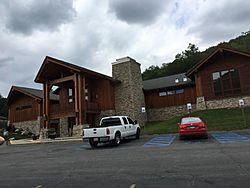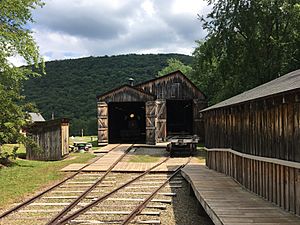Pennsylvania Lumber Museum facts for kids
Quick facts for kids Pennsylvania Lumber Museum |
|
|---|---|

Visitor center
|
|
| Location | Ulysses Township, Potter County, Pennsylvania, USA |
| Nearest city | Galeton, Pennsylvania |
| Governing body | Pennsylvania Historical and Museum Commission |
The Pennsylvania Lumber Museum is a cool place located near Galeton, Pennsylvania. It's in Potter County, which is in the state of Pennsylvania, USA. This museum tells the amazing story of the lumber industry. Lumber was super important for Pennsylvania's growth. It also changed the environment a lot.
At the museum, you can take tours and learn how people used to cut down trees. They also have fun workshops and classes. Sometimes, you can even watch exciting lumberjack competitions!
Pennsylvania's Forest History
Imagine Pennsylvania hundreds of years ago! Before William Penn and his Quaker friends arrived in 1682, most of Pennsylvania was covered in thick forests. About 90% of the state, over 20 million acres, was trees. These forests had tall white pine and Eastern hemlock trees. There were also many different kinds of hardwood trees.
Today, almost all of those huge, old forests are gone. The first trees cut down were near early settlements like Philadelphia. Settlers used the wood to build homes, barns, and even ships. They also cleared land for farming.
As more people arrived, the need for wood grew. By the time of the American Revolution, lumberjacks were cutting trees deep in Pennsylvania's mountains. Very tall and straight white pine and hemlock trees were perfect for ship masts. Workers tied these logs together into rafts. They floated them down the Susquehanna River and Delaware River. These rafts traveled to cities like Baltimore and Philadelphia.
Some early settlers saw a chance to start businesses. They built sawmills powered by water along creeks. Soon, lumber became one of Pennsylvania's most important industries. Besides building homes and ships, wood was used for many things. It heated homes, made tannin for leather, and built furniture. It was also used for barrels, rifle stocks, and shingles. Even the first Conestoga wagons were made from Pennsylvania's abundant timber.
The Lumber Boom
The lumber industry in Pennsylvania grew huge in the mid-1800s. Skilled lumbermen from New England came to Williamsport in 1846. They built the Susquehanna Boom. A "boom" is like a floating fence across a river. It catches logs floating downstream.
The Susquehanna Boom worked for over 50 years. From 1861 to 1891, it processed over 5.5 billion board feet of lumber. This made Williamsport a very rich city. It had more millionaires per person than any other city at that time!
Then, steam trains arrived in Pennsylvania's mountains. This changed the lumber industry again. Most of the white pine forests were already cut. So, lumbermen started cutting the huge stands of hemlock trees. Railroad companies built tracks into areas that were too hard to reach before. Trains could move many more trees much faster than floating logs down rivers.
This speed also caused problems. Sparks from the steam engines often started massive forest fires. These fires destroyed young trees that were growing to replace the old ones. The steam trains helped the lumber industry grow fast, but they also sped up its end. Many lumber "boom towns" popped up in the mountains during this time.
One of the biggest lumber operations was the Beaver Mill Lumber Company. It was in Centre County. Two lumber towns, Beaver Mills and Antes, grew around it. They changed the landscape a lot. They built mill ponds where beaver ponds used to be. These towns had large general stores, blacksmith shops, and schools. One school building is still standing today! These areas helped provide wood for mining, building, and railroads across the country.
The Decline of Lumber
The lumber boom didn't last forever. By the 1920s, most of the trees were gone. When the trees disappeared, the people who worked in lumber towns soon left too. They moved to places like West Virginia and the Great Lake States.
The lumber companies left behind a landscape that was bare and damaged. There was a lot of erosion (soil washing away) and many wildfires. The state of Pennsylvania then bought thousands of acres of this deforested land.
The state started a huge project to replant the forests. The Civilian Conservation Corps helped with this massive effort. Today, the old forests of hemlock and white pine have been replaced. Now, there are thriving "second growth" forests, mostly made up of different kinds of hardwoods.




